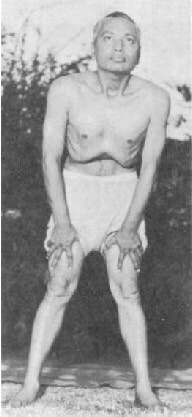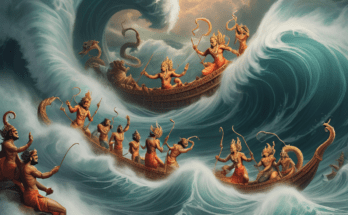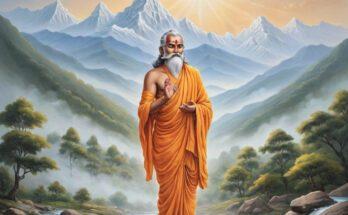Following excerpt has been taken from yoga-age.com. We do not take any credit for this write up here. However we are publishing it here as it really important part of yoga and are esteemed in high regard by well known siddhas over the time. I found a reference to these kriyas in the discourse given by Devaraha baba who lived for many centuries and was a great yogi.
MUDRAS AND BANDHAS
Exercises
Mudras and Bandhas are certain postures of the body by which Kundalini is successfully awakened. In Gheranda Samhita, the description of 25 Mudras and Bandhas, is given. The following 12 are the most important:—
| 1. Mula Bandha 2. Jalandhara Bandha 3. Uddiyana Bandha 4. Maha Mudra 5. Maha Bandha 6. Maha Vedha |
7. Yoga Mudra 8. Viparitakarani Mudra 9. Khechari Mudra 10. Vajroli Mudra 11. Shakti Chalana Mudra 12. Yoni Mudra |
Many of the above exercises have intimate connection with each other. In one exercise you will have to combine 2 or 3 Bandhas and Mudras. This you will see when you see the description. Many aspirants are not able to find out the exact technique of several Mudras that are described in Hatha Yogic texts, and therefore they could not realise the benefits.
Yogic exercises when practised regularly in the right way, will surely bestow on you all that you want.
Nasti mudrasamam kinchit
Siddhidam kshitimandale
“There is nothing in this world like Mudras for giving success.”
Dyspepsia, constipation, piles, cough, asthma, enlargement of spleen, venereal diseases, leprosy and all sorts of incurable diseases are cured by Mudras and Bandhas. They are the most effective exercises for maintaining Brahmacharya, without which nothing can be made in the spiritual path.
1. Mula Bandha
Press the Yoni with the left heel. Keep the right heel pressed at the space just above the organ of generation. Contract the anus and draw the Apana Vayu upwards. This is called Mula Bandha. The Apana Vayu which does the function of ejection of excreta has natural tendency to move downwards. Through the practice of Mula Bandha, the Apana Vayu is made to move upwards by contracting the anus and by forcibly drawing it upwards. The Prana Vayu is united with the Apana and the united Prana-Apana Vayu is made to enter the Sushumna Nadi. Then the Yogi attains perfection in Yoga. Kundalini is awakened. The Yogi drinks the Nectar of Immortality. He enjoys Siva-pada in Sahasrara Chakra. He gets all divine Vibhutis and Aishvarya. When the Apana is united with Prana, Anahata sounds (mystical inner sounds) are heard very distinctly. Prana, Apana, Nada and Bindu unite and the Yogi reaches perfection in Yoga. This highest stage cannot be reached by the first attempt. One should practise this again and again for a long time.
The Siddhi in the practice of Pranayama is attained through the help of Bandhas and Mudras. The practice of Mula Bandha enables one to keep up perfect Brahmacharya, gives Dhatu-Pushti (nerve-vigour), relieves constipation and increases Jatharagni. During the practice of concentration, meditation, Pranayama and all other Yogic Kriyas, Mula Bandha can be combined.
2. Jalandhara Bandha
Contract the throat. Press the chin firmly against the chest. This Bandha is practised at the end of Puraka and beginning of Kumbhaka. Generally this Bandha is done during Kumbhaka only. The gastric fire, which is situated in the region of Nabhi, consumes the nectar which exudes out of the Sahasrara Chakra through the hole in the palate. This Bandha prevents the nectar being thus consumed.
3. Uddiyana Bandha
The Sanskrit word “Uddiyana” comes from the root ‘ut’ and ‘di’ which means to “fly up.” When this Bandha is practised the Prana flies up through the Sushumna Nadi. Hence the significant name.
Empty the lungs by a strong and forcible expiration. The lungs will become completely empty when you exhale forcibly through the mouth. Now contract and draw up the intestines above and below the navel towards the back, so that the abdomen rests against the back of the body high up in the thoracic cavity. This is Uddiyana Bandha. This is practised at the end of Kumbhaka and beginning of the Rechaka. When you practise this Bandha, the diaphragm, the muscular portion between the thoracic cavity and abdomen, is raised up and the abdominal muscles are drawn backwards. If you bend your trunk forwards, you can easily do this exercise. Uddiyana Bandha is the first stage of Nauli Kriya. You should know Uddiyana Bandha if you want to practise Nauli Kriya. Nauli Kriya is generally done in a standing position. Uddiyana Bandha can be practised in a sitting or standing posture. When you do it while standing, keep your hands on the thigh as shown in the illustration.
This exercise helps a lot in keeping up Brahmacharya. It imparts beautiful health, strength, vigour and vitality to the practitioner. When it is combined with Nauli Kriya, it serves as a powerful gastro-intestinal tonic. These are the two potent weapons of the Yogin to combat against constipation, weak peristalsis of the intestines and other disorders of the alimentary canal. It is by these two Yogic Kriyas alone, that you can manipulate and massage all the abdominal muscles. For abdominal exercises nothing can compete with Uddiyana Bandha and Nauli. They stand unique and unrivalled amongst all systems of physical exercises. In chronic diseases of stomach and intestines, where drugs of all sorts have failed, Uddiyana and Nauli have effected a rapid, thorough and marvellous cure.
When you practise Pranayama, you can beautifully combine Mula Bandha, Jalandhara Bandha and Uddiyana Bandha. This is Bandha-Traya.
Uddiyana Bandha reduces fat in the belly. In cases where Marienbud reduction pills have failed to reduce fat, Uddiyana Bandha will work wonders. If fatty persons stop taking ghee and reduce the quantity of drinking water, they will be able to do Uddiyana. A trip to Kedar-Badri or Mount Kailas by foot will prepare fatty people for the practice of Uddiyana Bandha.

UDDIYANA BANDHA
4. Maha Mudra
This is the most important of all Mudras. Hence it is called ‘Maha Mudra.’ Press the anus carefully with the left heel. Stretch out the right leg. Catch hold of the toe with the two hands. Inhale and retain the breath. Press the chin against the chest firmly (Jalandhara Bandha). Fix the gaze between the eyebrows (Bhrumadhya Drishti). Retain the posture as long as you can and then exhale slowly. Practise first on the left leg and then on the right leg.
This cures consumption, haemorrhoids or piles, enlargement of spleen, indigestion, Gulma (chronic gastritis), leprosy, constipation, fever and all other diseases. Life is increased. It confers great Siddhis on the practitioners. Generally the Yogi does Maha Mudra, Maha Bandha and Maha Vedha. This is a good combination. Then only maximum benefits are derived. Do like this six times in the morning and evening.
5. Maha Bandha
Maha Mudra is the preliminary exercise for this. Press the anus with the left heel. Place the right foot upon the left thigh. Contract the anus and muscles of the perineum. Draw the Apana Vayu upwards. Draw the breath slowly and retain it by Jalandhara Bandha as long as you can. Then exhale slowly. Practise first on the left side and then on the right side. The Bandha destroys decay and death. The Yogi achieves all his desires and obtains Siddhis.
6. Maha Vedha
Sit in Maha Bandha posture. Draw the breath slowly. Retain the breath. Press the chin against the chest. Place the palms on the ground. Rest the body on the palms. Raise the buttocks slowly and strike them gently against the ground. The Asana must be intact and firm when you raise the buttocks. This Kriya destroys decay and death. The Yogi gets control over the mind and conquers death. There is not much difference between Maha Mudra, Maha Bandha and Maha Vedha. They are something like 3 stages of one exercise.
7. Yoga Mudra
Sit in Padmasana. Place the palms on the heels. Exhale slowly and bend forwards and touch the ground with the forehead. If you retain the pose for a long time, you can breathe as usual. Or come to the former position and inhale. Instead of keeping the hands on the heels, you can take them to the back. Catch hold of the left wrist with your right hand. This pose removes all kinds of disorders of the abdomen.
8. Viparitakarani Mudra
Lie on the ground. Raise the legs up straight. Support the buttocks with the hands. Rest the elbows on the ground. Remain steady. The sun dwells at the root of the navel and the moon at the root of the palate. The process by which the sun is brought upward and the moon is carried downward is called Viparitakarani Mudra. The positions of the sun and the moon are reversed. On the first day do it for a minute. Gradually increase the period to three hours. After six months wrinkles on the face and grey hair disappear. The Yogin who practises this for three hours daily conquers death. As the gastric fire is increased, those who practise this Mudra for a long time should take some light refreshment such as milk, etc., as soon as the Kriya is over. Sirshasana posture also is called Viparitakarani Mudra.
9. Khechari Mudra
‘Kha’ means Akasa and ‘Chari’ means to move. The Yogi moves in the Akasa. The tongue and the mind remain in the Akasa. Hence this is known as Khechari Mudra.
This Mudra can be performed by a man, only if he has undergone the preliminary exercise under the direct guidance of a Guru, who is practising Khechari Mudra. The preliminary portion of this Mudra is in making the tongue so long that the tip of the tongue might touch the space between the two eyebrows. The Guru will cut the lower tendon of the tongue with a bright, clean knife little by little every week. By sprinkling salt and turmeric powder, the cut edges may not join together again. Cutting the lower tendon of the tongue should be done regularly, once a week, for a period of six months. Rub the tongue with fresh butter and draw it out. Take hold of the tongue with the fingers and move it to and fro. Milking the tongue means taking hold of it and drawing it as the milkman does the udder of a cow during milking. By all these means you can lengthen the tongue to reach the forehead. This is the preliminary portion of Khechari Mudra.
Then turn the tongue upwards and backwards by sitting in Siddhasana so as to touch the palate and close the posterior nasal openings with the reversed tongue and fix the gaze on the space between the two eye-brows. Now leaving the Ida and Pingala, Prana will move in the Sushumna Nadi. The respiration will stop. The tongue is on the mouth of the well of nectar. This is Khechari Mudra.
By the practice of this Mudra the Yogi is free from fainting, hunger, thirst and laziness. He is free from diseases, decay, old age and death. This Mudra makes one an Oordhvaretas. As the body of the Yogi is filled with nectar, he will not die even by virulent poison. This Mudra gives Siddhis to Yogins. Khechari is the best of all Mudras.
10. Vajroli Mudra
This is an important Yogic Kriya in Hatha Yoga. You will have to work hard to get full success in this Kriya. There are very few people who are experts in this act. Yogic students draw water first through a silver-tube (catheter specially made) passed into the urethra 12 inches inside. After due practice they draw milk, then oil, honey, etc. They draw mercury in the end. Later on they can draw these liquids directly through the urethra without the help of the silver-tube. This Kriya is of immense use for keeping up perfect Brahmacharya. On the first day you should send the catheter inside the urethra for one inch only, the second day two inches, third day three inches, and so on. You must gradually practise till you are able to send 12 inches of the catheter inside. The way becomes clear and blowing. Raja Bhartrihari could do this Kriya very dexterously.
Even a drop of semen cannot come out of the Yogi who practises this Mudra. Even if it is discharged, he can draw it back through this Mudra. The Yogi, who draws his semen up and preserves it, conquers death. Good smell emanates from his body.
The late Trilingaswami of Varanasi was an expert in this Kriya. Sri Swami Kuvalayanandaji of Lonavala teaches this Mudra.
Some persons call the Mayurasana Vajroli Mudra. Again Vajroli Mudra is also known as Yoni Mudra. However, the description of Yoni Mudra is given separately.
The object of Vajroli Mudra is to be perfectly established in Brahmacharya. When aspirants practise this Mudra, they unconsciously divert their mind to sexual centres and thereby they cannot get any success. When you see the description of this Mudra, you will clearly understand that strict Brahmacharya is absolutely necessary. For practising this there is no necessity at all for a woman or for any sexual intercourse. Since the Grihasthas have their wives and because they think that Vajroli Mudra is a device for birth-control, they have a keen desire to practise this Mudra. It is all mere foolishness and delusion. They have not understood the technique and object of this important Kriya.
Practice of Mula Bandha, Maha Bandha, Maha Mudra, Asanas, Pranayamas, etc., will naturally enable one to understand and to get success in the practice of Vajroli. This must be done under the direct guidance of a Guru.
11. Shakti Chalana Mudra
Sit in a secluded room in Siddhasana. Draw in the air forcibly and join it with Apana. Do Mula Bandha till the Vayu enters the Sushumna. By retaining the air, the Kundalini, feeling suffocated, awakes and finds its way through Sushumna to Brahmarandhra.
Sit in Siddhasana. Take hold of the foot near the ankle and slowly beat the Kanda with the foot. This is Tadana Kriya. By this method also Kundalini can be awakened. Through the practice of this Mudra one can become a Siddha.
12. Yoni Mudra
Sit in Siddhasana. Close the ears with the two thumbs, eyes with the index-fingers, nostrils with the middle-fingers, the upper lips with the ring-fingers and the lower lips with the little fingers. This is a beautiful pose for doing Japa. Dive deep and meditate on the Shat Chakras and Kundalini. This is not quite easy for all like other Mudras. You have to exert much in getting success in this. You must be perfectly established in Brahmacharya if you want sure success. “Devanamapi durlabha”—very difficult to be obtained even by Devas. Therefore realise the importance of this Mudra and practise it very cautiously. Vajroli Mudra also is called Yoni Mudra.
Other Mudras
There are Sambhavi, Manduki, Aswini, Tadagi, Matangini, Bhuchari, Aghori and various other Mudras. Here I have told you only the important Mudras. For the instructions of all the Mudras, refer to book “Hatha Yoga.”
Instructions On Mudras And Bandhas
1. Maha Mudra, Maha Bandha and Maha Vedha form one group. They are something like three stages of one exercise. Similarly Mula Bandha, Uddiyana Bandha and Jalandhara Bandha form another group. Mula Bandha is practised during Puraka, Kumbhaka, Rechaka and during meditation and Japa also. Uddiyana Bandha is practised during Rechaka and Jalandhara Bandha during Kumbhaka.
2. As in the case of other Yogic Kriyas, Mudras and Bandhas also should be practised when the stomach is empty. General instructions that are given for Asanas and Pranayamas should be followed for the practice of Mudras.
3. The benefits that are given may not be realised by the practice of Mudras alone. You will have to combine Pranayamas, Asanas, Japa and other Yogic Kriyas.
4. Khechari Mudra should be done under the direct guidance of a Khechari Guru. Cutting the lower tendon should be carefully done at regular intervals. Aspirants may not be successful in this Kriya if they begin after 25 years of age when the muscles and nerves have become stiff.
5. Khechari, Shakti Chalana, Vajroli and other advanced courses should not be practised by all. The aspirants should ascertain from the Guru if they are fit for such advanced exercises and also they should see if they have all other requirements for the practice.
6. Uddiyana Bandha is also called Tadagi Mudra. Seet-Krama and Vyut-Krama described in the ‘Neti’ exerciseare called Matangini Mudra. Do Mula Bandha. Release it. Again and again do like this. It is termed Aswini Mudra.
7. Those who have not undergone the preliminary portion of Khechari Mudra (making the tongue long) can simply keep the tongue turned upwards on the palate. This is Nabho Mudra or Manduki Mudra.
8. Real success in Mudras can be had only if there is intense concentration of mind
Dibhu.com is committed for quality content on Hinduism and Divya Bhumi Bharat. If you like our efforts please continue visiting and supporting us more often.😀
Tip us if you find our content helpful,
Companies, individuals, and direct publishers can place their ads here at reasonable rates for months, quarters, or years.contact-bizpalventures@gmail.com





